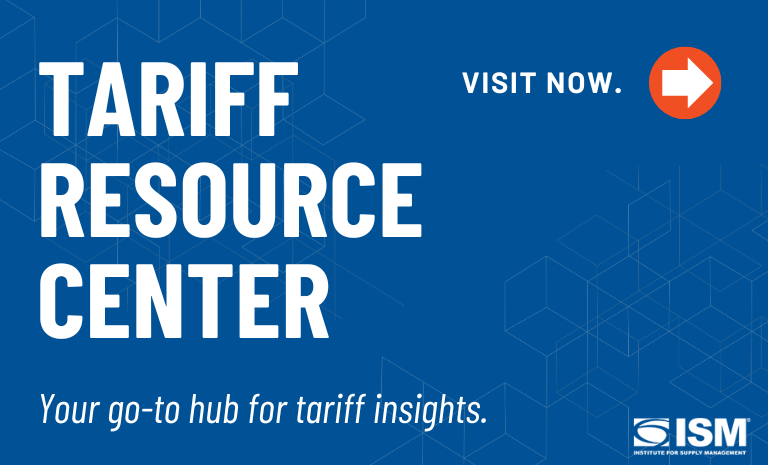ISM® PMI® Reports Roundup: October Manufacturing

During the ISM® Manufacturing PMI® Report media conference call on Monday, one of the participants noted an irony: The manufacturing sector is supposed to be a beneficiary of U.S. trade and tariffs policy.
However, the October PMI® data and survey respondents’ comments indicate that while there was welcome relief in a Prices Index reading below 60 percent for the first time in nine months, tariffs remain a headache impacting cost and price management, order levels and supplier delivery performance.
Those dynamics were partly reflected in a composite index reading of 48.7 percent, down 0.4 percentage point compared to September and below analysts’ expectations. The underlying factors like the percentage of the sector in strong contraction — more on that later — suggest more of the same in the coming months, said Susan Spence, MBA, Chair of the Institute for Supply Management® (ISM®) Manufacturing Business Survey Committee.
The latest ISM manufacturing report points to a slow but steady slowdown. The index slipped to 48.7 in Oct. , an eighth straight month of contraction. Factory employment and new orders improved slightly, while price pressures eased, suggesting cooling rather than collapse.…
— Mark Hamrick (@hamrickisms) November 3, 2025
“I’m tired of reporting bad news as much as people are tired of hearing it,” she said. “All the demand indicators were better than last month, but I need to remind myself they’re still in contraction. I feel like sometimes we’ve adjusted the measuring stick of what is good: OK, it’s not expansion, but it's not as bad as last month.”
Three demand indexes increased but remained in contraction territory: New Orders to 49.4 percent, New Export Orders to 44.5 percent and Backlog of Orders to 47.9 percent. The Customers’ Inventories Index also improved to 43.9 percent, within the “too low” range considered a positive for future production, as companies have to reorder at some point.
But product levels on shelves have been lower for months, and a new orders surge hasn’t commenced. Spence added, “We seem to be in this stagnant area, creeping toward expansion in a few areas but only temporarily. And with panelists reporting what their customers are doing — or not doing — that gets my concern meter up.”
It is not politicization to state that tariffs under the Trump administration are not popular among manufacturing companies and supply chain professionals. In October, 54 percent of Manufacturing Business Survey panelists’ comments were on tariffs, making it the No. 1 topic for yet another month.
Wrote a panelist in Machinery, “Tariffs continue to be a large impact to our business. The products we import are not readily manufactured in the U.S., so attempts to reshore have been unsuccessful. Overall, prices on all products have gone up, some significantly. We are trying to keep up with the wild fluctuations and pass along what costs we can to our customers.”
Relief could be coming from the trade agreement between the U.S. and China announced last week, with the key elements being (1) Beijing suspending export controls on rare earths and (2) Washington pausing some of the reciprocal tariffs. It’s “a great start,” Spence said, but companies will likely wait to see that tariff “whiplash,” as she put it, doesn’t strike again.
“It may take a few months to make sure nothing is undone,” she said. “The overall tone (from panelists) is that we don’t know what countries coming next or what commodity is coming next. They are saying there has been such volatility and uncertainty that needs to settle down.”
Nine mentions of tariffs in October's ISM Manufacturing PMI comments section pic.twitter.com/KEF4ozmK0c
— Kevin Gordon (@KevRGordon) November 3, 2025
Industry performance and the share of manufacturing gross domestic product (GDP) in strong contraction (meaning an industry-specific PMI® of 45 percent or lower) remain concerns.
In October, 41 percent of manufacturing GDP contracted strongly, up from 28 percent the previous month. Three of the industries in strong contraction — Chemical Products, Machinery and Petroleum & Coal Products — are among the largest in the sector.
Yet, the PMI® continues to reflect only mild contraction, as do the key demand indexes. Is this a sign of resiliency, or a coming sector correction? Any impact from tax cuts in the “One Big Beautiful Bill” and another interest-rate cut from the U.S. Federal Reserve will be tempered as long as demand remains tepid and trade policy volatile, Spence said.
“Companies are not hiring people because the orders aren’t coming in and prices are rising,” she said. “So, they have to conserve money because they want to hit their profit margin. If you spend capital, you need to know there’s no volatility that could cause it to become a bad decision by the time you open your doors.”
In other index news:
- The Supplier Deliveries Index indicated longer lead times with an increase of 1.6 percentage points to 54.2 percent; that’s not a result of increased demand, but rather tariffs gumming up purchasing negotiations and delivery processes.
- The Prices Index reading of 58 percent was the lowest since January (54.9 percent).
- The Employment Index registered 46 percent, an increase of 0.7 percentage point as there were 3.4 panelist comments on downsizing for every one on adding workers.
The ISM® PMI® Reports roundup:
Barron’s: ISM Survey Shows Tariffs Are Still Weighing on U.S. Manufacturing. “One consequence of tariffs is higher prices. The index for pricing remained in growth territory at 58, down from 61.9 in September. So far, investors have shrugged off most tariff news, believing things will get better eventually. Broad-based improvement hasn’t showed up yet.”
Bloomberg: U.S. Manufacturing Shrinks for Eighth Month on Sluggish Demand. “The survey illustrates general malaise among the nation’s manufacturers who are contending with lingering uncertainty around trade policy. Producers are navigating evolving supply chains as they source materials. The (Supplier Deliveries Index) rose to a four-month high, indicating longer lead times.”
CNBC: ISM Manufacturing PMI® Comes in Light at 48.7. On (the Employment Index), we would have had the (federal) jobs numbers, but we’re not getting them because of the government closure: This comes in light at 46 percent, but it is sequentially higher than last month at 45.3 percent,” analyst Rick Santelli said. “It’s actually the best going back to May, when it was 46.8 percent, and to show how weak that is, the only number in expansion territory (in 2025) was the first month of the year, at 50.3 percent.”
Logistics Management: Manufacturing Output Heads Down in October for Eighth Consecutive Month. “Tariffs and the economy were once again the main themes cited in ISM panelist comments. And a Computer & Electronic Products panelist said that the unpredictability of the tariff situation continues to cause havoc and uncertainty on future pricing/cost, while adding that even with the tariffs, the cost to import in many cases is still more attractive than sourcing within the U.S.”
Manufacturing Dive: U.S. Manufacturing Dips Despite Improved Demand. “Notably, (the Customers’ Inventories Index was) in the ‘too low’ category, which ISM found encouraging for customer reorders in the near future, (Spence said). However, increased costs and trade uncertainty could impact orders and operations.”
MarketWatch: ‘Business Continues to be Severely Depressed’: U.S. Manufacturers Blame Tariffs. “(Panelists) came through loud and clear: High and constantly shifting tariffs have raised costs, depressed sales and pressured companies to lay off employees. There wasn’t really any good news. Production declined. New orders contracted for the eighth time in the past nine months. Manufacturers trimmed the size of their labor force. Employment hasn’t grown since January.”
On November 3, the #GDPNow model nowcast of real GDP growth in Q3 2025 is 4.0%: https://t.co/T7FoDdgYos. #ATLFedResearch
— Atlanta Fed (@AtlantaFed) November 3, 2025
Download our EconomyNow app or go to our website for the latest GDPNow nowcast: https://t.co/NOSwMl7Jms. pic.twitter.com/tricz2HxHB
Reuters: U.S. Manufacturing Contracts Further in October; Supplier Delivery Times Lengthen. “Factories continued to pay more for inputs, though the pace of price increases moderated. The (Prices Index) eased to a still-high 58 percent from 61.9 percent in the prior month. That would support some economists' views that the hit to inflation from tariffs could be a one-time boost to the price level.”
The Wall Street Journal: U.S. Factory Activity Contracts at Faster Pacer as Production Lags. “The Prices Index continued to show increases, but at a slower rate than September … a potential relief for Federal Reserve policymakers concerned over inflation. Nevertheless, tariffs and their impact on prices and demand feature highly in respondents to the survey.”
The ISM® Services PMI® Report will be unveiled on Wednesday. For the most up-to-date content on the ISM® PMI® Reports, use #ISMPMI on X, formerly known as Twitter.

